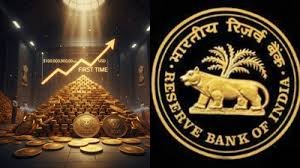Amid global geopolitical uncertainty and rising inflation risks, the Reserve Bank of India continues to strengthen its gold reserves, signaling confidence in the precious metal’s role as a safe and strategic asset.
New Delhi, October 24, 2025 — Economy India Report
India’s central bank has quietly fortified its financial arsenal with one of the oldest symbols of wealth — gold. The Reserve Bank of India (RBI) has reported that its total gold holdings have now crossed 880.18 metric tonnes (8,80,180 kg) as of September 2025.
According to RBI’s latest bulletin, the value of this gold reserve stood at approximately $95 billion, equivalent to ₹8.4 lakh crore, marking one of the strongest gold positions in India’s monetary history.
In the first six months of FY2025-26 (April–September) alone, RBI added 0.6 metric tonnes (600 kg) of gold to its reserves — with 200 kg purchased in September and 400 kg in June. During the previous fiscal year (2024–25), the central bank had expanded its gold stock by 54.13 metric tonnes, reflecting a consistent strategy of diversification and stability.

Why the Central Bank is Buying More Gold
The RBI’s increasing preference for gold is a direct response to global economic volatility, inflationary pressures, and geopolitical tensions. The metal remains a crucial hedge against uncertainty.
“Gold continues to play a pivotal role as a safe asset class in the face of currency fluctuations and inflation risks,” the RBI noted in its report.
During the six-month period ending September 2025, central banks across the world collectively purchased 166 tonnes of gold, contributing to sustained price strength globally. This surge in institutional demand pushed global prices to record highs in September, impacting both international and Indian markets.
Gold Reserves: India’s Strategic Shield Against Economic Volatility
Gold serves as an essential pillar of India’s macroeconomic stability. The metal provides the RBI with a reliable hedge against foreign exchange risks, particularly in times when the rupee faces downward pressure.
1. Economic Stability
Gold offers intrinsic value, retaining purchasing power even during currency depreciation or financial crises.
2. Diversification of Reserves
By adding gold to its forex basket, RBI reduces dependency on the U.S. dollar and euro, achieving a more balanced and resilient reserve composition.
3. Inflation Protection
Gold historically outperforms during inflationary periods, protecting the value of the country’s reserves.
4. Global Credibility
A substantial gold reserve enhances India’s international financial standing, ensuring investor confidence and economic credibility.
Lessons from the 1991 Crisis
India’s economic history underscores the importance of gold reserves. In 1991, facing a severe balance-of-payments crisis, India was compelled to pledge 67 tonnes of gold to raise foreign exchange and avert default.
The current accumulation strategy reflects the RBI’s intent to avoid such vulnerabilities in the future and to strengthen India’s economic sovereignty.
Global Trends Driving Gold Prices Up
Gold’s rising value in 2025 is linked to several macroeconomic forces:
- Heightened geopolitical risks in Europe and the Middle East.
- Persistent global inflation, despite cooling energy prices.
- Lower interest rate expectations by the U.S. Federal Reserve, which has weakened the dollar.
- Increased demand from Asian central banks, particularly China and India.
This combination has pushed global gold prices to record levels, while Indian consumers face higher jewelry costs ahead of the festive season.
Gold and the Common Citizen: How It Affects You
Gold’s macroeconomic impact isn’t limited to central banks — it touches the daily lives of ordinary Indians too.
Jewelry Prices
As gold prices rise, jewelry becomes costlier, especially during festivals and wedding seasons — times when demand peaks across India.
Investment Returns
Retail investors holding gold ETFs or sovereign gold bonds have seen higher returns, while those looking to buy are facing elevated entry costs.
Loans and Collateral
Higher gold prices mean more loan value against pledged jewelry, benefitting small borrowers and rural households.
Inflationary Impact
Soaring gold prices can signal broader inflationary trends, influencing prices of essential goods and financial instruments.
The Inverse Link Between Gold and Currencies
The RBI report highlights a fundamental truth — gold and major currencies move inversely.
When the U.S. dollar weakens, global gold prices rise. This is because gold is priced in dollars, and investors seek the metal as a stable alternative.
In countries experiencing currency depreciation, gold becomes a store of value and a protective asset against loss of purchasing power.
How Global Gold Prices Are Determined
Several factors influence the international price of gold:
- Supply and Demand Dynamics — Mining output and recycling volumes.
- London Bullion Market Association (LBMA) — Sets benchmark prices twice daily.
- Economic Indicators — Inflation, interest rates, and GDP growth.
- Geopolitical Events — Wars, sanctions, or financial crises.
- Speculative Trading — Commodities exchanges like COMEX drive short-term price movements.
India’s Gold in Global Perspective
India ranks among the top 10 nations in official gold holdings, after the U.S., Germany, Italy, and France. RBI’s steady accumulation underscores a strategic long-term vision to secure the country’s economy against global shocks.
Gold as a Pillar of Economic Confidence
With 880 tonnes of gold valued at over ₹8.4 lakh crore, India’s central bank continues to project economic confidence and financial prudence.
RBI’s sustained accumulation reflects trust in tangible assets amid volatile global markets. Gold is no longer merely a symbol of prosperity — it’s a strategic shield safeguarding India’s economic future.
(Economy India)









